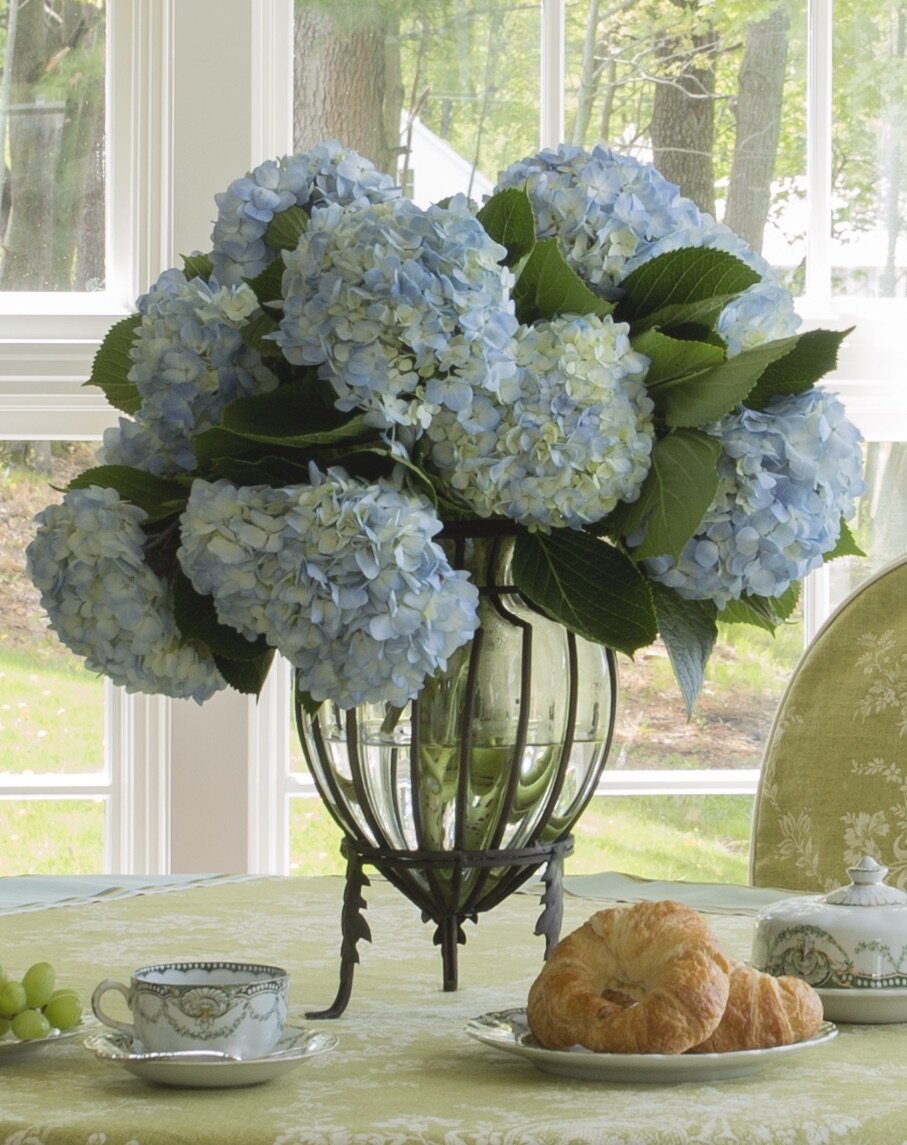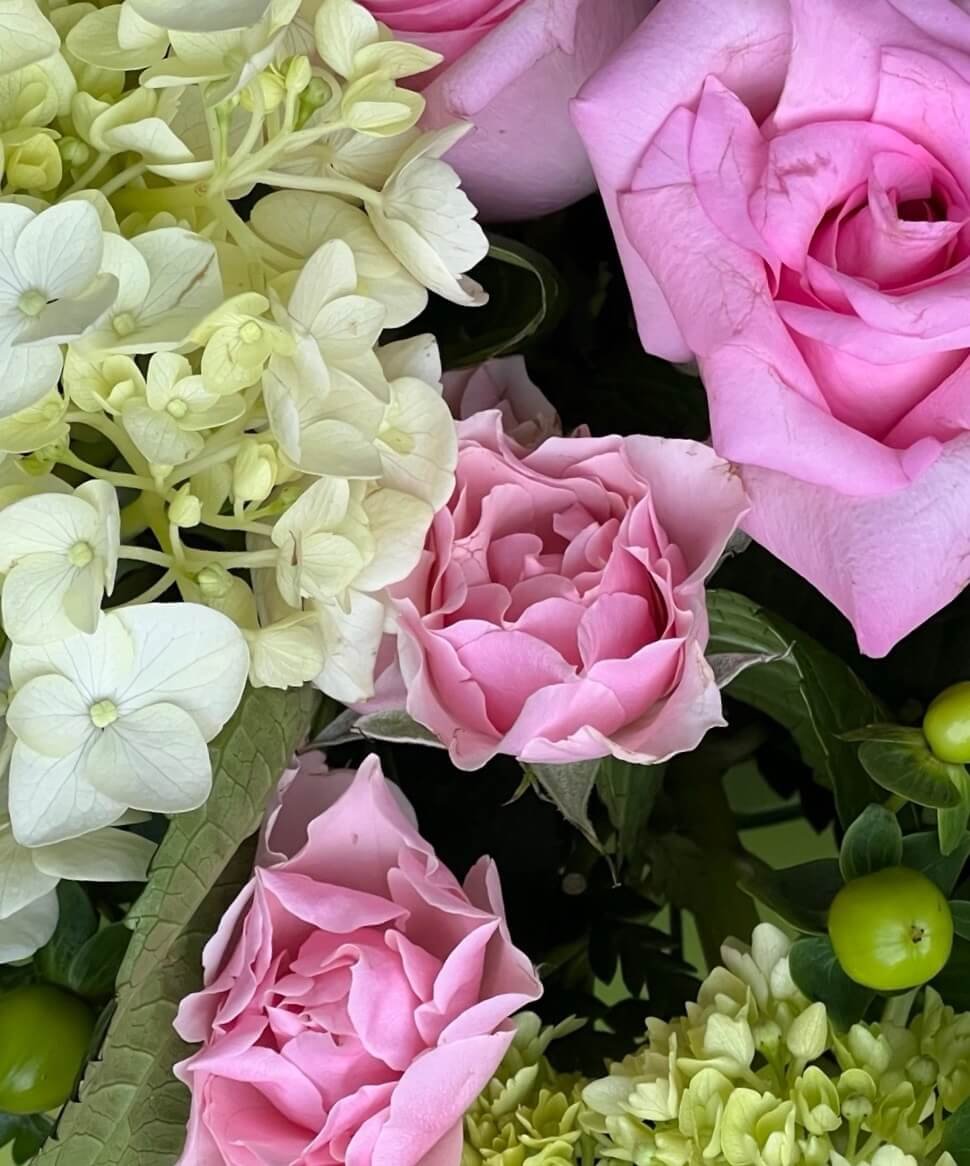Nothing adds to a room as much as fresh flowers. It is, by far, the simplest and easiest way to give a room a lift and add some life. If you do nothing but add a nice arrangement to your coffee table, it can elevate the whole room!
I just attended an online flower arranging zoom workshop recently that was hosted by a FB community where I am a member. It was a fun hour of seeing friends and learning a bit more about the art of arranging flowers.
Today I’m sharing a bit about easy ways to arrange flowers and things I’ve learned over the years to help create a successful display.
Scale
First you need to decide on the size of the arrangement you have in mind and this will depend on where you would like to put it. Keep in mind how the space will be used.
If you want an arrangement for the dining room table, for example, you probably want to keep it lower to avoid dining parties having to play peek-a-boo across the table. More tips on easy dining centerpieces HERE.
If you are placing it on a console table against a wall, you’ll want to keep in mind the scale in relation to the things around it and the room.
But once you have decided on the relative size, it is time to choose a container.
Choosing a container
Almost anything can be a container for an arrangement, but the bigger it is, the more flowers you will need to make it feel lush and abundant.
If you want to use something not watertight (a basket/box/totebag or whatever), just insert a watertight container into it to use for your flowers.
The height of the container can be generally around 1/2 the overall height of the arrangement and 1/3 of the overall width. Of course you can break this ‘rule’, but it is a good place to start for traditional arrangements.
The vase that was delivered with the flowers for our zoom class seemed so small in comparison to the flower stems, but turned out to be just the right size for scale of the arrangement.
this short glass vase is approximately half the height of the overall arrangement
Choosing flowers
The easiest arrangements are all one type of showstopping flower - like peonies or hydrangeas. If you are lucky enough to have these in your yard, they are wonderful options to cut for arrangements!
For more variegated arrangements though, choose the following categories:
Greens (like leatherleaf ferns) for the base of the arrangement
Showy larger flowers - hydrangea, lilies, peonies, dahlias…choose an odd number. Use at least 3 for larger arrangements use more.
Medium flowers - again, choose odd numbers starting usually with 5 - roses, mums, tulips, asters
Branchy flowers (multiples on one stem) and berries to drape and fill in
In addition to contrast in size, you will want to be sure there is texture and shape contrast in the varieties of flowers that you choose.
In our zoom class arrangement, the pompom texture of the hydrangeas contrasts with the concentric traditional rose petals and the ruffled branch roses. The compact smooth berry sprays add another size and texture to the mix.
Flower arranging tools
Please note: this post contains affiliate links meaning I may make a small commission on any purchases at no additional cost to you. Click on highlighted text for link to purchase.
If your arrangement will be viewed from multiple sides, it is much easier to create the arrangement on a turntable or lazy susan (I used my cake decorating turntable) so you can check the view as you add
Sharp scissors or a floral knife for cutting the stems…professionals prefer a knife to avoid compacting the stems
Flower food (or a little sugar and a splash of vodka (this prevents bacteria, it doesn’t make your flowers tipsy 😂)
If you have a very low container, floral foam can be helpful…soak it thoroughly before use - the right way to hydrate floral foam is to let it sink on its own in a container of water with flower food, this prevents air pockets and apparently takes only a couple of minutes. I’ve also seen flower frogs or tape crisscrossed across the top of the container used to help hold flower stems in place.
Arranging tips
Keep your cut stems in water with flower food in a cool dark place until ready to use.
Add flower food to room temperature water in your vase.
If you need the flowers to open faster, say for an event or dinner party, use hotter water…of course this also sometimes shortens the life of some of the flowers in an arrangement.
Begin with the base of greens.
Remove any leaves that will be below the waterline to prevent rot and bacteria.
Most flowers benefit from removing all or most of the leaves. Hydrangea leaves will soak up the water that needs to keep the bloom hydrated so definitely remove the majority of those leaves!
Cut stems at an angle to maximize water intake. For woody stems (like hydrangeas), cut an additional slit up the stem an inch or so to increase the chances of water absorption.
The biggest mistake most people make is leaving the stems too long - if you remember that 50% of the height is the vase, this helps. The tallest central flowers will be the maximum height, and the periphery flowers will be cut a bit shorter for an overall mounded shape to the arrangement.
Begin with the largest blooms in your arrangement and work down to the smallest, placing them fairly evenly dispersed.
To extend the life of the arrangement…
Watch the water level and add water so all the stems are stay submerged.
Replace the food infused water every few days and recut the stems
Remove spent blooms and fill in with new ones, or move the party to a smaller container(s).
The flowers below are the last surviving blooms from a Mother’s Day bouquet…I’m realizing I need to trim down that one purple one that looks like a periscope 😂
the last of an older bouquet trimmed and relocated to a small jar
Special thanks to Yvonne Blacker and Alice’s Table for a fun event, and to The Hothouse Facebook Community for organizing it!









